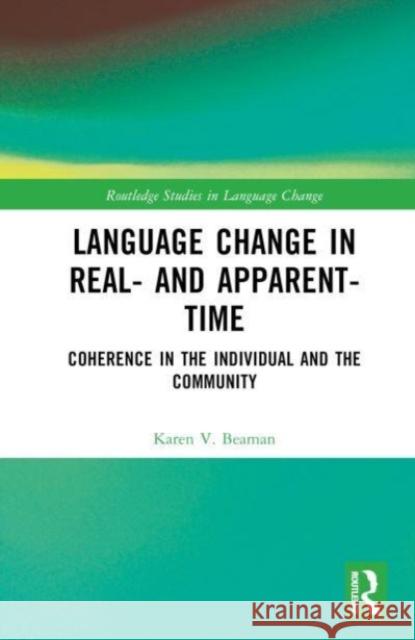Language Change in Real- and Apparent-Time » książka



Language Change in Real- and Apparent-Time
ISBN-13: 9781032212166 / Twarda / 2024 / 318 str.
Language Change in Real- and Apparent-Time
ISBN-13: 9781032212166 / Twarda / 2024 / 318 str.
(netto: 669,47 VAT: 5%)
Najniższa cena z 30 dni: 690,82
ok. 22 dni roboczych
Dostawa w 2026 r.
Darmowa dostawa!
This volume explores the use of the Swabian dialect in southwestern Germany. This book will be of interest to students and scholars in sociolinguistics, linguistic anthropology, dialectology, and historical linguistics.
Wydanie ilustrowane
Contents
LIST OF FIGURES
LIST OF TABLES
ACKNOWLEDGEMENTS
SYMBOLS AND CONVENTIONS
CODES AND ABBREVIATIONS
CHAPTER 1. INTRODUCTION TO LIFESPAN AND COMMUNITY CHANGE
1.1. Introduction
1.2. Challenges To the Critical-Period Hypothesis
1.3. Approaches To Studying Language Change
1.4. Individual And Community Patterns of Linguistic Change
1.5. Theoretical Underpinnings and Methodological Framework for This Book
1.6. Structure And Contributions of This Book
CHAPTER 2. METHODS FOR THE STUDY OF REAL- AND APPARENT-TIME LANGUAGE CHANGE
2.1. Introduction
2.2. The Swabian Language and People
2.3. The Corpus
2.4. Data Collection and Preparation
2.5. The Linguistic Variable(S)
2.5.1 Phonological Variables
2.5.1 Morphosyntactic Variables
2.6. Measuring Dialect Density
2.7. Socio-Demographic Factors of Language Change
2.7.1 Speaker Community
2.7.2 Speaker Gender
2.7.3 Speaker Age
2.7.4 Speaker Education
2.7.5 Speaker Social Class
2.8. Change In Real- And Apparent-Time
2.9. Change Across the Lifespan
2.10. Individual And Community Change
2.11. Summary
CHAPTER 3. THE SPEECH COMMUNITY AND URBAN/RURAL DIVIDE
3.1. Introduction
3.2. Speech Communities
3.2.1 Stuttgart
3.2.2 Schwäbisch Gmünd
3.3. Urbanity And Rurality
3.3.1 Regionality and Dialect Use
3.3.2 Community Differences Over Time
3.3.3 The Impact of Higher Education
3.4. The Role of Social Networks
3.5. Coherence In the Speech Community
3.5.1 Covariation Analysis
3.5.2 Measuring Community Coherence
3.5.3 Variable Weightings
3.6. Summary
CHAPTER 4. DIALECT CONTACT, LEVELING AND SUPRAREGIONALIZATION
4.1. Introduction
4.2. Dialect Contact and Levelling
4.3. Rise Of Supralocal and Supraregional Varieties
4.4. Standard Language Convergence
4.5. Dialect Levelling In Swabia
4.5.1 Frequency Distributional Analysis
4.5.2 Lifespan and Community Change
4.5.3 Interactions Between The Linguistic And Social
4.6. Indexicalities Of Linguistic Variables
4.6.1 Variable Family
4.6.2 Variable Salience
4.6.3 Variable Stigma
4.6.4 Variable Status
4.7. Supraregionalization In Swabia
4.8. Summary
CHAPTER 5. INDEXICALITIES OF IDENTITY, ACCOMMODATION, AND MOBILITY
5.1. Introduction
5.2. Linguistic Accommodation
5.3. Local Orientation and Identity Construction
5.4. Perpetual Mobility and Humanity
5.5. Cultural Indices as Indicators Of Dialect Use
5.5.1 Local Orientation
5.5.2 Interlocutor Accommodation
5.5.3 Speaker Mobility
5.6. Multivariate Analysis
5.7. Summary
CHAPTER 6. EXAMPLES OF LINGUISTIC CHANGE ACROSS LIFESPAN AND THE COMMUNITY
6.1. Introduction
6.2. (Ai) Diphthong
6.2.1 Background
6.2.2 Measuring Diphthong Trajectories
6.2.3 Diphthong Change in Real- And Apparent-Time
6.2.4 Local Orientation and Loss of Diphthong Contrast
6.2.5 Internal Linguistic Factors and Diphthong Change
6.2.6 The Interaction of The Linguistic and Social
6.2.7 Discussion
6.3. (Wo) Relatives
6.3.1 Background
6.3.2 The Linguistic Variable and The Envelope of Variation
6.3.3 Frequency Distribution Of (Wo) Relatives
6.3.4 Multivariate Analysis Of (Wo) Relatives
6.3.5 Discussion
6.4. Summary
CHAPTER 7. CONCLUSIONS AND LOOKING FORWARD
7.1. Introduction
7.2. Compatibility Of Combined Panel and Trend Studies
7.3. Dialect Levelling and Supraregionalization in Swabian
7.4. Indexicalities And Social Meaning
7.5. Methodological And Theoretical Contributions to The Field of Sociolinguistics
7.6. Opportunities For Future Research
7.7. Summary
ENDMATTER
APPENDIX A. INTERVIEW DOCUMENTS
A.1. Sociolinguistic interview
A.2. Reading passage
A.3. Word list
A.4. Minimal pairs
A.5. Socio-demographic questionnaire
APPENDIX B. DATA TRANSCRIPTION CONVENTIONS
B.1. Transcription philosophy
B.2. ELAN transcription conventions
B.3. Transcript storage and security
APPENDIX C. E2R DATA EXTRACTION AND ANNOTATION PROCESS
C.1. ELAN transcript processing
C.2. TextGrid creation
C.3. Tier validation
C.4. Tag validation
C.5. Word extract processing
C.6. Clause extract processing
C.7. Aligner processing
C.8. Phone extract processing
C.9. Formant extract processing
C.10. Speaker social information
APPENDIX D. SWABIAN-GERMAN LEXICON
REFERENCES
INDEX
Karen V. Beaman is is a Lecturer of sociolinguistics at the University of Tübingen, Germany. Her primary research is a comparative study of Swabian, a dialect spoken in southwestern Germany, which combines a 35-year panel study with a five-generation trend study. Her work investigates language variation and change in both real- and apparent-time, with particular focus on how factors of identity, mobility and social networks drive or inhibit change.
1997-2025 DolnySlask.com Agencja Internetowa
KrainaKsiazek.PL - Księgarnia Internetowa









